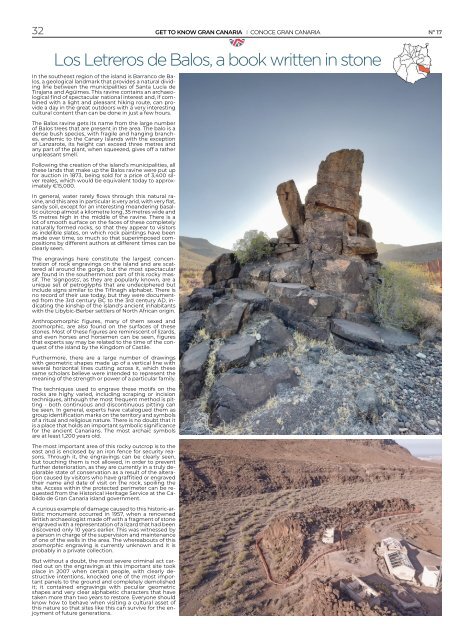No. 17 - Its Gran Canaria Magazine
Rutas, recomendaciones y noticias de Gran Canaria. Routes, tips and news about Gran Canaria.
Rutas, recomendaciones y noticias de Gran Canaria.
Routes, tips and news about Gran Canaria.
Create successful ePaper yourself
Turn your PDF publications into a flip-book with our unique Google optimized e-Paper software.
32<br />
GET TO KNOW GRAN CANARIA I CONOCE GRAN CANARIA Nº <strong>17</strong><br />
Los Letreros de Balos, a book written in stone<br />
In the southeast region of the island is Barranco de Balos,<br />
a geological landmark that provides a natural dividing<br />
line between the municipalities of Santa Lucía de<br />
Tirajana and Agüimes. This ravine contains an archaeological<br />
find of spectacular national interest and, if combined<br />
with a light and pleasant hiking route, can provide<br />
a day in the great outdoors with a very interesting<br />
cultural content than can be done in just a few hours.<br />
The Balos ravine gets its name from the large number<br />
of Balos trees that are present in the area. The balo is a<br />
dense bush species, with fragile and hanging branches,<br />
endemic to the Canary Islands with the exception<br />
of Lanzarote, its height can exceed three metres and<br />
any part of the plant, when squeezed, gives off a rather<br />
unpleasant smell.<br />
Following the creation of the island’s municipalities, all<br />
these lands that make up the Balos ravine were put up<br />
for auction in 1873, being sold for a price of 3,400 silver<br />
reales, which would be equivalent today to approximately<br />
€15,000.<br />
In general, water rarely flows through this natural ravine,<br />
and this area in particular is very arid, with very flat,<br />
sandy soil, except for an interesting meandering basaltic<br />
outcrop almost a kilometre long, 35 metres wide and<br />
15 metres high in the middle of the ravine. There is a<br />
lot of smooth surface on the faces of these completely<br />
naturally formed rocks, so that they appear to visitors<br />
as indelible slates, on which rock paintings have been<br />
made over time, so much so that superimposed compositions<br />
by different authors at different times can be<br />
clearly seen.<br />
The engravings here constitute the largest concentration<br />
of rock engravings on the island and are scattered<br />
all around the gorge, but the most spectacular<br />
are found in the southernmost part of this rocky massif.<br />
The 'signposts', as they are popularly known, are a<br />
unique set of petroglyphs that are undeciphered but<br />
include signs similar to the Tifinagh alphabet. There is<br />
no record of their use today, but they were documented<br />
from the 3rd century BC to the 3rd century AD, indicating<br />
the kinship of the island's ancient inhabitants<br />
with the Libybic-Berber settlers of <strong>No</strong>rth African origin.<br />
Anthropomorphic figures, many of them sexed and<br />
zoomorphic, are also found on the surfaces of these<br />
stones. Most of these figures are reminiscent of lizards,<br />
and even horses and horsemen can be seen, figures<br />
that experts say may be related to the time of the conquest<br />
of the island by the Kingdom of Castile.<br />
Furthermore, there are a large number of drawings<br />
with geometric shapes made up of a vertical line with<br />
several horizontal lines cutting across it, which these<br />
same scholars believe were intended to represent the<br />
meaning of the strength or power of a particular family.<br />
The techniques used to engrave these motifs on the<br />
rocks are highy varied, including scraping or incision<br />
techniques, although the most frequent method is pitting<br />
- both continuous and discontinuous pitting can<br />
be seen. In general, experts have catalogued them as<br />
group identification marks on the territory and symbols<br />
of a ritual and religious nature. There is no doubt that it<br />
is a place that holds an important symbolic significance<br />
for the ancient <strong>Canaria</strong>ns. The most archaic symbols<br />
are at least 1,200 years old.<br />
The most important area of this rocky outcrop is to the<br />
east and is enclosed by an iron fence for security reasons.<br />
Through it, the engravings can be clearly seen,<br />
but touching them is not allowed, in order to prevent<br />
further deterioration, as they are currently in a truly deplorable<br />
state of conservation as a result of the alteration<br />
caused by visitors who have graffitied or engraved<br />
their name and date of visit on the rock, spoiling the<br />
site. Access within the protected perimeter can be requested<br />
from the Historical Heritage Service at the Cabildo<br />
de <strong>Gran</strong> <strong>Canaria</strong> island government.<br />
A curious example of damage caused to this historic-artistic<br />
monument occurred in 1957, when a renowned<br />
British archaeologist made off with a fragment of stone<br />
engraved with a representation of a lizard that had been<br />
discovered only 10 years earlier. This was witnessed by<br />
a person in charge of the supervision and maintenance<br />
of one of the wells in the area. The whereabouts of this<br />
zoomorphic engraving is currently unknown and it is<br />
probably in a private collection.<br />
But without a doubt, the most severe criminal act carried<br />
out on the engravings at this important site took<br />
place in 2007 when certain people, with clearly destructive<br />
intentions, knocked one of the most important<br />
panels to the ground and completely demolished<br />
it; it contained engravings with peculiar geometric<br />
shapes and very clear alphabetic characters that have<br />
taken more than two years to restore. Everyone should<br />
know how to behave when visiting a cultural asset of<br />
this nature so that sites like this can survive for the enjoyment<br />
of future generations.

















